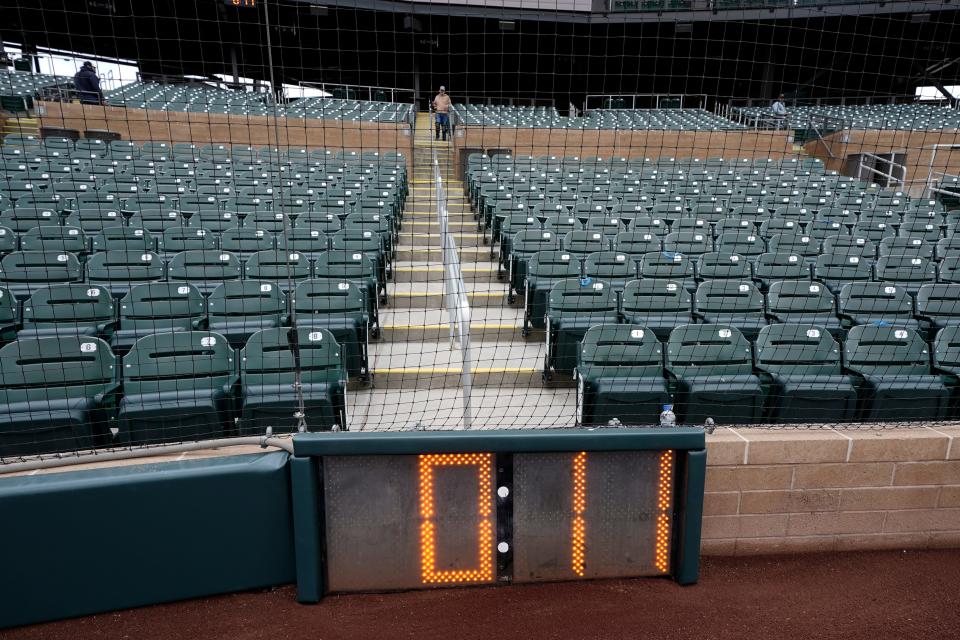MLB pitch clock will make games faster in 2023, but it's a big adjustment for all involved

Major League Baseball is introducing a set of significant rule changes for the 2023 season. One of those rules is aiming to have America's Pastime not pass so much time.
MLB is implementing a pitch clock in an effort to speed up the pace of play and, at least at the major league level, this year's spring training is acting as the trial period. It's taking some getting used to, and that includes everyone involved.
What to look for in Goodyear:Guardians spring training 2023: The top 5 storylines to watch this spring camp
The new pitch clock rules include a 30-second timer between batters and a time limit between pitches. After receiving the ball, pitchers must begin their motion within 15 seconds when there aren't runners on base and 20 seconds if there are men on base. If they don't, they'll be charged with an automatic ball. Pitchers are also only permitted with two "disengagements" (like stepping off the rubber or throwing to a base) per plate appearance.
Hitters are also involved. Batters must be in the box and engaged with the pitcher — meaning eyes up and ready to hit — by the time the clock reaches eight seconds. If not, they'll be charged with an automatic strike. A batter can also only call time out once per plate appearance.
2023 Major League Baseball spring training games shortened an average of 20 minutes
The early responses to the rule: it's working, but it's a real adjustment for all involved. MLB games reached an all-time high with an average time of three hours and 11 minutes in 2021. Last year, it was three hours and six minutes. So far this spring, games have been an average of 20 minutes shorter. And in the minors last year, when pitch clocks were implemented, games were cut by an average of 25 minutes.
Guardians manager Terry Francona is having to force himself to not focus so much on the clock, considering the many other things a manager has to worry about during games. But that's why the time to acclimate to the new rules this spring is so valuable.
"We've kind of gotten caught up in looking at the clock … which … I've never in my whole life had to do," Francona told reporters in Goodyear, Ariz. "I want to watch the game and see how we can figure out how to beat the other team, and I've caught myself looking at the clock, which in reality I can't do anything about it. So I need to start just paying attention to the game. But we'll get to that. Players are probably doing similar stuff. They'll figure it out and we'll figure it out."
The league has already seen some interesting results with the rule change. A game between the Boston Red Sox and Atlanta Braves ended in a tie when the game's final better was called out via an automatic strike. Of course, a tie won't happen during the regular season, but it's entirely possible a game ends or goes to extra innings due to the rule, which makes it imperative to keep the clock in mind at all times.
For players, it isn't just paying attention to the clock. Pitchers and batters being limited in how often they can disengage is also a major piece to all of this. An example Francona pointed out: outfielder Steven Kwan, as he's digging in and setting up in the box, has the habit of holding his arm out to the umpire to effectively call time until he's ready. It's a very common practice among hitters and has been for some time. Now, if Kwan is still doing that once the clock hits the 8-second mark, it'll count as a timeout because he isn't ready to hit. If he does it twice in the same at-bat, it'll be an automatic strike.
Francona noted one instance in which he kept asking questions during a game to the umpire to make sure everyone was on the same page. He's certainly not alone in this, as managers across baseball have noted something similar. The umpires, too, are having to find their own rhythm in how they call games. It's even a question as to exactly how the timers work in different stadiums, and whether there could be differences game by game in how quickly the pitch clock starts, similar to dealing with differences in an umpire's strike zone on a nightly basis.
"[One umpire] came over and he had 22 pages [of the rules] and I said, 'I'm complaining about page 17,'" Francona said, laughing. "He goes, 'It's going fast for us, too.' I think the one thing they did tell me was that the younger umpires that they've talked to all (who have done this before) said it kind of finds its pace. So we've got to let it happen."
Ryan Lewis can be reached at rlewis@thebeaconjournal.com. Read more about the Guardians at www.beaconjournal.com/sports/cleveland-guardians. Follow him on Twitter at @ByRyanLewis.
This article originally appeared on Akron Beacon Journal: MLB pitch clock will shorten games in 2023, but everyone's adjusting
